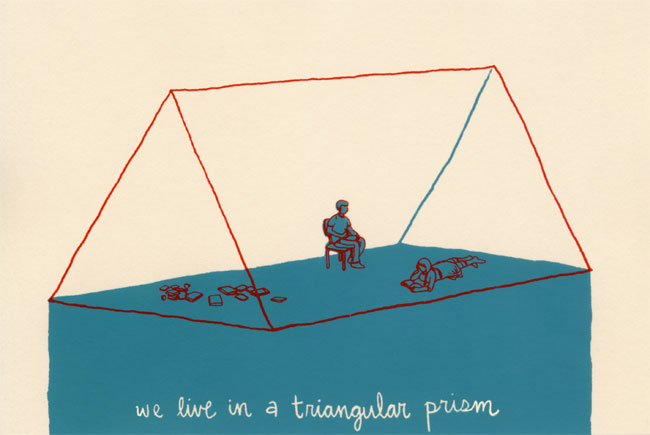Issue 5 - Home

Attic Living, by Colleen MacIsaac
I was sitting in the Trident last week reading about how Bruce Nauman, a contemporary American installation artist, made a large sign, sixty-feet long by thirty-feet wide, to hang inside his front door. The sign is made of tubes of neon lights and spells, “Honey, you’re home!” Upon reading this, I had an immediate compulsion to make a similar sign for myself: an enormous wall-hanging, ideally some sort of hooked-rug or afghan but, due to a laziness I prefer to call “efficiency,” I planned to settle for magic marker on brown craft paper instead.
The temporariness of this quickly crafted sign seems appropriate for my – now short-term – home. I will be leaving both my house and this city in a few weeks, yet I have never felt more at home here, more at ease, than now, as I wait to leave it.
Perhaps this is because Halifax is a city of longing. The large student population infuses this Maritime city with a kind of seasonal transience. Even geographically, Halifax feels impermanent, poised for relocation elsewhere. The neck of land on which we live is precariously jutting from the Eastern edge of the country; it sometimes seems like it might just snap right off the map. As both peninsula and port, Halifax belongs as imperfectly to the mainland as it does to the sea that laps at its limits. To live in Halifax is therefore, in a sense, to be already looking beyond it, along a latitude of longing that runs as far east as west. I am not exempt from this longing, and I am subject to the pull in both directions: I am going west in August, subletting an apartment in New York; come September, I’m heading eastward to Paris, where I’ll be living and working.*
Halifax, as Sean Flinn said in his article on Joel Plaskett in May 28th’s issue of The Coast, “is a borderland between land and sea, which is not just a geographic reality but a psychological reality too – a state of being in between (sometimes stuck, other times secure).” I too feel this tension between the desire to put down roots and the urge to transplant myself to foreign soil. After seeing a photography exhibit at the Art Gallery of Nova Scotia, I felt the acute emptiness that is often associated with transience: Iain BAXTER&’s photographs of his road trips throughout Western North America depicted an empty, flat world unaffected by his lens. His subjects have denied him entrance into their lives and landscape, and that denial has become his subject. The title of the exhibition is, aptly, “Passing Through.”
The work featured in this issue is by artists who, while they may be just “passing through” Halifax, engage with and explore the nature of our relationship to the idea of “home.” The issue moves forward from the feeling of entrapment and confinement in the physicality of home to the idea that home is something you can either break free from or carry with you, like a tortoise and his shell. “Home” is something that we are constantly building and that, like a sandcastle, can be washed away. The fact that this is an online issue – though originally due to a lack of funds – is now a way of positively embracing this transience.
I finished the brown-paper sign and hung it in my hallway; I think I will leave it to my roommates to take down once I leave. When making this poster, I had another impulse, simultaneous and of equal strength to the first: to make a smaller version of this same insignia that I could carry around with me; a portable sign to hang in the many homes that I will inevitably inhabit. This way, wherever I go, I will be reminded that I am “home,” and that home is something we are all always in the process of making for ourselves.
Harriet Alida Lye
Editor